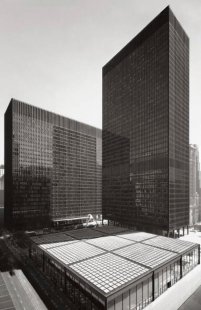
Position Statement on the Planned Demolition of the Chemapol-Invest Building in Prague-Vršovice
Source
Rostislav Švácha, místopředseda Klubu Za starou Prahu
Rostislav Švácha, místopředseda Klubu Za starou Prahu
Publisher
Tisková zpráva
18.10.2021 21:30
Tisková zpráva
18.10.2021 21:30
Czech Republic
Prague
Vršovice
Zdenka Marie Nováková
Dagmar Šestáková
The Club for Old Prague expresses great concern and disagreement with the intention to demolish the building of the former foreign trade enterprise Chemapol-Investa, today Kodaňská Office Center s. r. o., located at Kodaňská Street 1441/46 in Prague-Vršovice.
This building, designed by architects Zdena Nováková and Dagmar Šestáková from 1967 to 1970, is one of the most important examples of Czechoslovak architecture from the period of the "golden sixties" of the 20th century. Its authors were able to realize their project after winning an architectural competition in 1966. They conceived their work in the spirit of post-war American buildings by Ludwig Mies van der Rohe and achieved an expression that, in comparison with other similar works in Czechoslovakia—such as the Strojimport building in Prague-Vinohrady from 1961 to 1967 by the team of Zdeněk Kuna—most closely resembles Mies's buildings, both in its formal refinement and in the excellent landscaping surrounding the new building, including the preserved water feature with a sculpture by Karel Kronych.
Through such rapprochement of the architectural expression of domestic buildings with models from the democratic West, prominent Czechoslovak architects and architectesses of the sixties expressed their disagreement with the chimera of a specific "socialist" architecture and sought to emphasize the belonging of our architectural creation to the Western cultural sphere, which the architects Nováková and Šestáková excellently achieved in the conception of the Chemapol building. The building is evaluated in our art-historical literature as well, for example in the History of Czech Visual Art VI, 1958–2000 (Prague 2007, p. 56) or in the book by editors Oldřich Ševčík and Ondřej Beneš, Architecture of the 60s: "The Golden Sixties" in Czech architecture of the 20th century (Prague 2009, p. 60). The successful design of Chemapol was undoubtedly also aided by the glass façade technology from the Italian company Feal, artistic decorations of the building by leading figures of the domestic art scene at the time, and its thoughtful urban planning, which managed to cope with the disorganized and non-compact construction of the surroundings and brought a comprehensible order to it.
The building, it is true, was damaged by the colorful coating by French artist Yaacov Agam from 2003 to 2004, which is removable and did not significantly detract from its architectural and urban design. If the Chemapol building has not yet become the subject of interest of heritage preservation, it is undoubtedly because no one in heritage and architectural circles even contemplated that such an important architectural work should be demolished. The Club for Old Prague fundamentally disagrees with this demolition and calls on each of the addressees of this statement to contribute, within their means, to its prevention.
Prof. PhDr. Rostislav Švácha, CSc., signed Vice-Chairman of the Club for Old Prague
Doc. PhDr. Richard Biegel, Ph.D., signed Chairman of the Club for Old Prague
This building, designed by architects Zdena Nováková and Dagmar Šestáková from 1967 to 1970, is one of the most important examples of Czechoslovak architecture from the period of the "golden sixties" of the 20th century. Its authors were able to realize their project after winning an architectural competition in 1966. They conceived their work in the spirit of post-war American buildings by Ludwig Mies van der Rohe and achieved an expression that, in comparison with other similar works in Czechoslovakia—such as the Strojimport building in Prague-Vinohrady from 1961 to 1967 by the team of Zdeněk Kuna—most closely resembles Mies's buildings, both in its formal refinement and in the excellent landscaping surrounding the new building, including the preserved water feature with a sculpture by Karel Kronych.
Through such rapprochement of the architectural expression of domestic buildings with models from the democratic West, prominent Czechoslovak architects and architectesses of the sixties expressed their disagreement with the chimera of a specific "socialist" architecture and sought to emphasize the belonging of our architectural creation to the Western cultural sphere, which the architects Nováková and Šestáková excellently achieved in the conception of the Chemapol building. The building is evaluated in our art-historical literature as well, for example in the History of Czech Visual Art VI, 1958–2000 (Prague 2007, p. 56) or in the book by editors Oldřich Ševčík and Ondřej Beneš, Architecture of the 60s: "The Golden Sixties" in Czech architecture of the 20th century (Prague 2009, p. 60). The successful design of Chemapol was undoubtedly also aided by the glass façade technology from the Italian company Feal, artistic decorations of the building by leading figures of the domestic art scene at the time, and its thoughtful urban planning, which managed to cope with the disorganized and non-compact construction of the surroundings and brought a comprehensible order to it.
The building, it is true, was damaged by the colorful coating by French artist Yaacov Agam from 2003 to 2004, which is removable and did not significantly detract from its architectural and urban design. If the Chemapol building has not yet become the subject of interest of heritage preservation, it is undoubtedly because no one in heritage and architectural circles even contemplated that such an important architectural work should be demolished. The Club for Old Prague fundamentally disagrees with this demolition and calls on each of the addressees of this statement to contribute, within their means, to its prevention.
Prof. PhDr. Rostislav Švácha, CSc., signed Vice-Chairman of the Club for Old Prague
Doc. PhDr. Richard Biegel, Ph.D., signed Chairman of the Club for Old Prague
The English translation is powered by AI tool. Switch to Czech to view the original text source.


24 comments
add comment
Subject
Author
Date
nebourat
Raval
04.07.22 10:29
bourat, pryč s tou nepatřičnou stavbou
Eva Svítková
06.07.22 08:45
"... srozumitelný řád"
Vích
07.07.22 01:08
řád
robert
07.07.22 03:35
panelák a řád
Raval
07.07.22 07:30
show all comments













